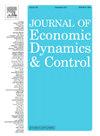基于临近预报宏观经济数据的SVAR识别
IF 2.3
3区 经济学
Q2 ECONOMICS
引用次数: 0
摘要
从理论观察出发,SVAR模型的识别问题源于宏观经济变量之间的同步依赖,我们从理论上和经验上都表明,这种依赖随着观测频率的增加而趋于消失。通过采用临近广播的高频数据,我们利用这一特征来识别使用标准短期限制的结构冲击,从而减少甚至消除对变量排序的依赖。我们的实证分析分为两个部分:一个是比较不同频率识别策略的说明性应用,一个是结构部分,其中包括(i)代理(HF-)SVAR来恢复外源性货币政策冲击,以及(ii)使用高频数据来复制文献中发现的众所周知的动态的不确定性冲击分析。结果与最近的发现一致,并强调了在所有变量中保留高频信息的可行性和实用性。本文章由计算机程序翻译,如有差异,请以英文原文为准。
SVAR identification with nowcasted macroeconomic data
Starting from the theoretical observation that the identification problem of SVAR models arises from contemporaneous dependence among macroeconomic variables, we show, both theoretically and empirically, that such dependence tends to vanish as the observation frequency increases. By adopting nowcasted high-frequency data, we exploit this feature to identify structural shocks using standard short-run restrictions, thereby reducing or even eliminating the reliance on variable ordering. Our empirical analysis is divided into two parts: an illustrative application comparing identification strategies across different frequencies, and a structural section featuring (i) a Proxy(HF-)SVAR to recover exogenous monetary policy shocks, and (ii) an uncertainty shock analysis using high-frequency data to replicate the well-known dynamics found in the literature. The results align with recent findings and highlight the feasibility and usefulness of preserving high-frequency information in all variables.
求助全文
通过发布文献求助,成功后即可免费获取论文全文。
去求助
来源期刊

Journal of Economic Dynamics & Control
ECONOMICS-
CiteScore
3.10
自引率
10.50%
发文量
199
期刊介绍:
The journal provides an outlet for publication of research concerning all theoretical and empirical aspects of economic dynamics and control as well as the development and use of computational methods in economics and finance. Contributions regarding computational methods may include, but are not restricted to, artificial intelligence, databases, decision support systems, genetic algorithms, modelling languages, neural networks, numerical algorithms for optimization, control and equilibria, parallel computing and qualitative reasoning.
 求助内容:
求助内容: 应助结果提醒方式:
应助结果提醒方式:


